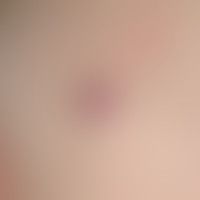Image diagnoses for "Torso"
551 results with 2173 images
Results forTorso

Seborrheic dermatitis of adults L21.9
Dermatitis, seborrhoeic: 62-year-old patient with a negative family history of psoriasis. recurrent HV on the trunk for years. no itching. multiple, chronically inpatient, figured, borderline, sometimes itchy, moderately scaly, clearly borderline hardly elevated plaques.

Circumscribed scleroderma L94.0
Morphea type or plaque type of circumscribed scleroderma: slightly idurated irregularly bordered white plaque with a parchment-like, scale-free surface; discreet, light red rimythema.

Kaposi's sarcoma (overview) C46.-
Kaposi's sarcoma epidemic: Dissemination of the angiosarcoma in the skin. Characteristic arrangement of the foci in the cleavage lines. In places the foci merge into larger plaques.

Acrodermatitis chronica atrophicans L90.4
acrodermatitis chronica atrophicans. 57-year-old female patient. skin changes existing for five years now, clearly increasing for half a year, discoloured red-blueish in cold weather. large, blurredly limited, symmetrical erythema (completely anaemic). the skin surface is wrinkled in the breast area (atrophic), otherwise smooth. some splatter-like white discolorations.

Incontinentia pigmenti (Bloch-Sulzberger) Q82.3
Incontinentia pigmenti, Bloch-Sulzberger type: a few weeks old girl with flat and streaky, inflammatory, in places hardly noticeable blistery skin changes.

Folliculitis perforating L73.8
Folliculitis, perforating. irregular distribution of follicular, itchy papules with a central horn plug in the area of the back.

Melanoma cutaneous C43.-
Melanoma malignes (overview): initial malignant melanoma, at routine examination as random finding.

Prurigo simplex subacuta L28.2
Prurigo simplex subacuta: 54-year-old female patient with a clinical picture that has been progressive for two years. severe, uncontrollable itching. the rough papules up to 0.8 cm in size with marginal hyperpigmentation are centrally eroded or ulcerated or even covered with older crusts (centre of the figure). a typical picture of itchy Prurigo simplex subacuta are the scratch artefacts limited to prurigo lesions.

Steroid acne L70.8

Pityriasis versicolor (overview) B36.0
pityriasis versicolor alba. large and small, slightly scaly, brown, bizarrely configured bright spots. detail view.

Incineration T30.0
2nd degree burn (Combustio bullosa): Erythema followed by extensive subepidermal blistering. Beginning incrustation. Painfulness.

Circumscribed scleroderma L94.0
Circumscriptal scleroderma (plaque-type/variant: Atrophodermia idiopathica et progressiva) Survey picture of the trunk: 2 years ago for the first time appeared, since then size progressive, large-area, erythematous-livid to brown, confluent, discreetly indurated spots and plaques in the region of the trunk in a 68-year-old female patient. In the region of the lower abdomen on the right side clearly sclerosed plaques of whitish color with partly distinctly atrophic surface and partly livid margins are found.

Acanthosis nigricans benigna L83
Acanthosis nigricans benigna: blurred brown-black spots and plaques. the plaques are characterized by a slightly sooted, leathery surface. no subjective symptoms.

Cherry angioma D18.01
Angioma senile. red brown, very soft papules, almost completely compressible by finger pressure, 0.7 cm in size. therapy not necessary

Pemphigus vulgaris L10.0
Pemphigus vulgaris: multiple, chronic, since 3 years intermittent, symmetric, trunk-accentuated, easily injured, flaccid, 0.2-3.0 cm large, red spots, plaques and pallor, confluent to, weeping and crusty surfaces; extensive infestation of the oral mucosa and capillitium.

Contagious mollusc B08.1
Molluscum contagiosa: multiple, 0.2-0.3 cm large, yellow-reddish, firm, shiny, completely asymptomatic nodules with characteristic central umbilical cord; appearing after first school swimming.

Solar dermatitis L55.-
Dermatitis solaris: painful erythema and blistering, clearly marked on sunlight-exposed areas. Skin peels off in stripes. This was preceded by several hours of sun exposure.







